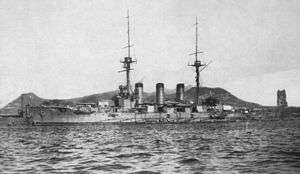Japanese battlecruiser Ibuki
 Ibuki | |
| History | |
|---|---|
| Name: | Ibuki |
| Namesake: | Mount Ibuki |
| Ordered: | 1904 Fiscal Year |
| Builder: | Kure Naval Arsenal |
| Laid down: | 22 May 1907 |
| Launched: | 21 October 1907 |
| Commissioned: | 11 November 1907 |
| Struck: | 20 September 1923 |
| Fate: | Scrapped, 20 September 1923 |
| General characteristics | |
| Class & type: | Ibuki-class battlecruiser |
| Displacement: | |
| Length: | [1] 140 m (450 ft) p.p.; 148 m (485 ft) oa |
| Beam: | 23 m (75 ft 6 in) |
| Draft: | 8 m (26 ft 3 in) |
| Installed power: | 24,000 shp (18,000 kW) |
| Propulsion: |
|
| Speed: | 21.5 kn (39.8 km/h; 24.7 mph) |
| Range: | 5,000 nmi (9,300 km; 5,800 mi) at 14 kn (26 km/h; 16 mph) |
| Capacity: | |
| Complement: | 844 |
| Armament: |
|
| Armor: | |
| Notes: | Armor is Krupp steel.[10] |
Ibuki (伊吹 巡洋戦艦 Ibuki jun'yōsenkan) was the lead ship in the Ibuki class of armored cruisers in the Imperial Japanese Navy. Ibuki was named after Mount Ibuki, located between Gifu and Shiga prefectures in Honshū. On 28 August 1912, the Ibukis were re-classified as battlecruisers.
Design and construction
Problems with her turbine engines delayed the construction of Ibuki, and construction began almost two years later than her sister ship, Kurama, which used standard reciprocating engines. Ibuki was built at Kure Naval Arsenal and was laid down on 22 May 1907, launched on 21 October 1907, and commissioned on 11 November 1907.
Operational history
Shortly after she was commissioned, Ibuki was sent on a voyage to Thailand to attend the coronation ceremony of the Thai king Rama VI Vajiravudh. Ibuki served in World War I, participating in the hunt for the German light cruiser SMS Emden. She escorted a convoy of 10 troop transports carrying the Main Body of the New Zealand Expeditionary Force, crossing the Tasman Sea with the British protected cruiser HMS Pyramus and armoured cruiser HMS Minotaur to Albany, Western Australia in November. Together with the Australian light cruiser HMAS Sydney, Ibuki escorted the ANZACs, consisting of 20,000 men and 7,500 horses, across the Indian Ocean.
At 8.55 the whole fleet moved ahead - thirty-six transports and three escorting cruisers. Two days later, the Ibuki with the great liners Ascanius and Medic carrying troops from South and Western Australia, was found waiting beside the route on the high seas, half-obscured by a rain squall. The two transports took up their places on the line. The Ibuki moved into the Melbourne's position on the starboard beam, while the Melbourne dropped immediately astern of the convoy. The whole fleet then headed for the Cocos Islands.— C.E.W. Bean, [11]
Ibuki was the only protection for the ANZACs when Sydney participated in the Battle of Cocos. The commander of Ibuki, Captain Kanji Katō[12] had wanted the honor of engaging Emden, but despite being a superior ship to Sydney was ordered to stand down and stay with the convoy. This was later celebrated by the Royal Australian Navy as the "samurai spirit of the Ibuki" whenever Imperial Japanese ships visited Australia in subsequent years.[12]
Fate
After the war, Ibuki fell victim to the Washington Naval Treaty and was sold for scrap on 20 September 1923. Her guns were salvaged and used in shore batteries at Hakodate in Hokkaidō and along the Tsugaru Strait separating Honshū and Hokkaidō.
Notes
- ↑ (2001) Jane's Fighting Ships of World War I, pg. 167. Random House, London. ISBN 1851703780
- ↑ (2001) Jane's Fighting Ships of World War I, pg. 167. Random House, London. ISBN 1851703780
- ↑ (2001) Jane's Fighting Ships of World War I, pg. 167. Random House, London. ISBN 1851703780
- ↑ (2001) Jane's Fighting Ships of World War I, pg. 167. Random House, London. ISBN 1851703780
- ↑ (2001) Jane's Fighting Ships of World War I, pg. 167. Random House, London. ISBN 1851703780
- ↑ (2001) Jane's Fighting Ships of World War I, pg. 167. Random House, London. ISBN 1851703780
- ↑ (2001) Jane's Fighting Ships of World War I, pg. 167. Random House, London. ISBN 1851703780
- ↑ (2001) Jane's Fighting Ships of World War I, pg. 167. Random House, London. ISBN 1851703780
- ↑ (2001) Jane's Fighting Ships of World War I, pg. 167. Random House, London. ISBN 1851703780
- ↑ (2001) Jane's Fighting Ships of World War I, pg. 167. Random House, London. ISBN 1851703780
- ↑ C.E.W. Bean, The Story of Anzac from the outbreak of war to the end of the first phase of the Gallipoli Campaign, May 4, 1915. Sydney: Angus & Robertson, 1939, p. 98-99
- 1 2 O'Brien, pp. The Anglo-Japanese alliance, 1902-1922, p. 142
References
- Evans, David (1979). Kaigun: Strategy, Tactics, and Technology in the Imperial Japanese Navy, 1887-1941. Naval Institute Press. ISBN 0-87021-192-7.
- Gardiner, Robert; Gray, Randal, eds. (1984). Conway's All the World's Fighting Ships: 1906–1921. Annapolis, Maryland: Naval Institute Press. ISBN 0-85177-245-5.
- Jentschura, Hansgeorg; Jung, Dieter; Mickel, Peter (1977). Warships of the Imperial Japanese Navy, 1869–1945. Annapolis, Maryland: United States Naval Institute. ISBN 0-87021-893-X.
- Jane's Fighting Ships of World War I. London: Random House Group, Ltd. 2001. p. 167. ISBN 1-85170-378-0.